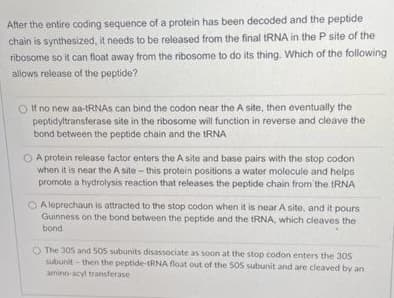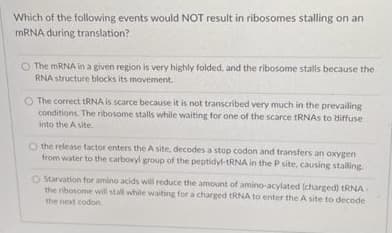After the entire coding sequence of a protein has been decoded and the peptide chain is synthesized, it needs to be released from the final tRNA in the P site of the ribosome so it can float away from the ribosome to do its thing. Which of the following allows release of the peptide? If no new aa-tRNAS can bind the codon near the A site, then eventually the peptidyltransferase site in the ribosome will function in reverse and cleave the bond between the peptide chain and the TRNA O A protein release factor enters the A site and base pairs with the stop codon when it is near the A site - this protein positions a water molecule and helps promote a hydrolysis reaction that releases the peptide chain from the tRNA O A leprechaun is attracted to the stop codon when it is near A site, and it pours Guinness on the bond between the peptide and the tRNA, which cleaves the bond O The 305 and 505 subunits disassociate as soon at the stop codon enters the 305 subunit- then the peptide-tRNA float out of the 505 subunit and are cleaved by an amino-acyl transferase
After the entire coding sequence of a protein has been decoded and the peptide chain is synthesized, it needs to be released from the final tRNA in the P site of the ribosome so it can float away from the ribosome to do its thing. Which of the following allows release of the peptide? If no new aa-tRNAS can bind the codon near the A site, then eventually the peptidyltransferase site in the ribosome will function in reverse and cleave the bond between the peptide chain and the TRNA O A protein release factor enters the A site and base pairs with the stop codon when it is near the A site - this protein positions a water molecule and helps promote a hydrolysis reaction that releases the peptide chain from the tRNA O A leprechaun is attracted to the stop codon when it is near A site, and it pours Guinness on the bond between the peptide and the tRNA, which cleaves the bond O The 305 and 505 subunits disassociate as soon at the stop codon enters the 305 subunit- then the peptide-tRNA float out of the 505 subunit and are cleaved by an amino-acyl transferase
Human Heredity: Principles and Issues (MindTap Course List)
11th Edition
ISBN:9781305251052
Author:Michael Cummings
Publisher:Michael Cummings
Chapter9: Gene Expression And Gene Regulation
Section: Chapter Questions
Problem 17QP: Given the following mRNA, write the double-stranded DNA segment that served as the template....
Related questions
Question

Transcribed Image Text:After the entire coding sequence of a protein has been decoded and the peptide
chain is synthesized, it needs to be released from the final RNA in the P site of the
ribosome so it can float away from the ribosome to do its thing. Which of the following
allows release of the peptide?
If no new aa-tRNAS can bind the codon near the A site, then eventually the
peptidyltransferase site in the ribosome will function in reverse and cleave the
bond between the peptide chain and the TRNA
O A protein release factor enters the A site and base pairs with the stop codon
when it is near the A site-this protein positions a water molecule and helps
promote a hydrolysis reaction that releases the peptide chain from the tRNA
O A leprechaun is attracted to the stop codon when it is near A site, and it pours
Guinness on the bond between the peptide and the RNA, which cleaves the
bond
O The 305 and 50s subunits disassociate as soon at the stop codon enters the 305
subunit - then the peptide-tRNA float out of the 505 subunit and are cleaved by an
amino-acyl transferase

Transcribed Image Text:Which of the following events would NOT result in ribosomes stalling on an
MRNA during translation?
The MRNA in a given region is very highly folded, and the ribosome stalls because the
RNA structure blocks its movement.
O The correct tRNA is scarce because it is not transcribed very much in the prevailing
conditions. The ribosome stalls while waiting for one of the scarce tRNAS to diffuse
into the A site.
O the release tactor enters the A site, decodes a stop codon and transfers an oxxYgen
from water to the carboxyl group of the peptidyl-tRNA in the P site, causing stalling
O Starvation for amino acids will reduce the amount of amino-acylated (charged) tRNA
the ribosome will stall while waiting for a charged tRNA to enter the A site to decode
the next codon
Expert Solution
This question has been solved!
Explore an expertly crafted, step-by-step solution for a thorough understanding of key concepts.
This is a popular solution!
Trending now
This is a popular solution!
Step by step
Solved in 2 steps

Recommended textbooks for you

Human Heredity: Principles and Issues (MindTap Co…
Biology
ISBN:
9781305251052
Author:
Michael Cummings
Publisher:
Cengage Learning

Biochemistry
Biochemistry
ISBN:
9781305577206
Author:
Reginald H. Garrett, Charles M. Grisham
Publisher:
Cengage Learning

Biology Today and Tomorrow without Physiology (Mi…
Biology
ISBN:
9781305117396
Author:
Cecie Starr, Christine Evers, Lisa Starr
Publisher:
Cengage Learning

Human Heredity: Principles and Issues (MindTap Co…
Biology
ISBN:
9781305251052
Author:
Michael Cummings
Publisher:
Cengage Learning

Biochemistry
Biochemistry
ISBN:
9781305577206
Author:
Reginald H. Garrett, Charles M. Grisham
Publisher:
Cengage Learning

Biology Today and Tomorrow without Physiology (Mi…
Biology
ISBN:
9781305117396
Author:
Cecie Starr, Christine Evers, Lisa Starr
Publisher:
Cengage Learning

Biology (MindTap Course List)
Biology
ISBN:
9781337392938
Author:
Eldra Solomon, Charles Martin, Diana W. Martin, Linda R. Berg
Publisher:
Cengage Learning